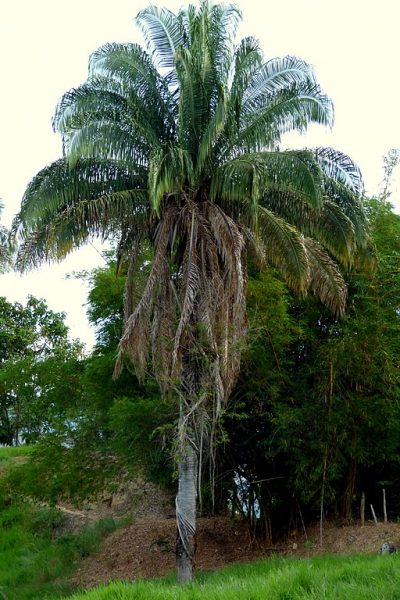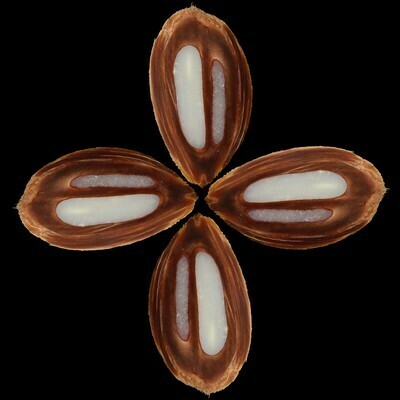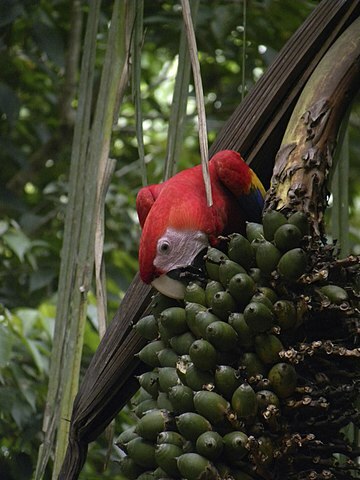
The species Attalea butyraceacommonly known as corozo, shebón, wine palm, royal palm, Cuesco, Corozo de marrano, cuma, coyoles, curumata or yagua, is a non-timber forest resource. It has diverse uses, and the potential to support the agro-industrial development of the Amazon Rainforest and other areas where it grows.
Taxonomy
The corozo or shebon is a palm belonging to the kingdom Plantae, class Liliopsida (monocotyledonous), family Palmae, genus Attalea and species Attalea butyracea (Devia, et. al, 2002) (1).

Geographical distribution
Attalea butyracea’s area of origin is Brazil; it is also found in southern Mexico, Guatemala, Costa Rica, and Panama; Venezuela and Trinidad and Tobago in the Caribbean; and the Amazon regions of Colombia, Peru, Ecuador, Bolivia and Brazil (Devia, et. al, 2002) (1).
Description of the Corozo Description of the
Attalea butyracea is a palm of great longevity and ample thickness; it is solitary, thornless, with deep roots. The tree can reach up to 25 meters in height and about 75 cm in diameter; its steam is light gray with very close rings. It has a crown composed of 25 to 40 pinnate leaves, slightly curled, distributed regularly or sometimes grouped on the rachis, whose length can range between six and twelve meters. It produces white-yellow flowers and fruits throughout the year, which acquire a yellowish color when ripe (Gamba-Trimiño, cited by Rodríguez, 2015) (3). The fruits are generally larger than three cm and have a very fibrous mesocarp. The endocarp is woody and thick, often reaching a thickness of one cm; inside are between one to four elongated seeds rich in oil (Galeano and Bernal, cited by Rodriguez, 2015) (3).

Uses and potentials of Attalea butyracea
Corozo is considered a multipurpose palm with potential for development. According to Devia, et. at (2002) (1), there are basically three parts of the plant that can be economically exploited: the leaves, the fruit and the heart of palm.
The principal use of its expanded leaves is to cover roofs. Brooms, hammocks, hats, baskets, fans and other items are made from the fiber obtained from the buds. These products are useful to local inhabitants and are also a source of income (Gómez, 2021) (2).
The palm fruit is useful in the agro-industrial sector. The pulp is used to prepare chicha on a domestic scale and is also used to feed pigs. Quality fat and oil are extracted from the seeds, offering great potential in the production of margarine and in the cosmetic industry. Royal palm or corozo cake is also obtained from the fruit (Gómez, 2021) (2).

In fact, activated carbon, vegetable oil and Corozo cake can be obtained from the fruit. Activated charcoal, vegetable oil and corozo cake can be also obtained from the fruit. Activated charcoal has numerous applications, including water purification, gas purification, removal of toxic vapors from the air, and general filtration. Vegetable oils derived from the palm are extracted from the kernel by two processes: pressing and solvent extraction. These processes obtain a product which has a pleasant coconut flavor; it is used in cosmetics (soaps, creams and hair products) and in the manufacture of margarines. Wine palm kernel (corozo) cake is a by-product obtained after oil extraction. It has a high protein content and energy value, and is used in animal feed (Devia, et. at, 2002) (1). et at, 2002) (1).
Palm wine and biofuel
Sap extracted from the trunk of the Corozo tree is used for wine production. A palm about 8 meters high, after being felled, produces approximately one liter of sap per day for 20 to 30 days, with a sucrose content of 11.7% However, this practice of cutting down the palm should be avoided as far as possible. Instead, extracting the sap from the flowers should be explored. This is traditionally done in Asia with other, related palm species. Some estimates shows that 42.7 kg. of sap per palm is produced each year by the “bleeding” of flowers (inflorescences). This is equivalent to a little more than 5 tons of sugar per year, making the Attalea butyracea a promising plant in industry and as a biofuel. (Gómez (2021) (2))
The yield of Corozo is higher than most of the oilseeds cultivated in the tropics, thus interest is high in exploiting it. However, harvesting must be carried out sustainably to preserve the environment and to conserve the species, in accordance with the 2030 Agenda for Sustainable Development.
Shebon ecosystem services
The wine palm is important for human nutrition. It provides raw materials for products, has cultural value via artisanal use of its fiber, and can generate income. . . . The palm also supports local fauna, by providing a microenvironment for communities of arthropods (insects, arachnids etc.) and small vertebrates that use it both as food and shelter. Domestic and wild animals also use the flowers and fruits as a food source. Other local environmental benefits include climate change mitigation, biodiversity preservation and air purification. (Salcedo, et. at (2018) (4))
References
- Devia, J., López, A., Saldarriaga, O. 2022. Promising products from the fruit of the wine palm. Revista Universidad EAFIT, (126), 67-80. Retrieved from%20-%
- Gómez, A. 2021. The ideal palm for silvopastoral systems: Attalea butyracea. El Palmicultor Bulletin, 591(May), 28-29. Retrieved from https://publicaciones.fedepalma.org/index.php/palmicultor/article/view/13491
- Rodríguez Eraso, N. 2015. Conservation and management plan for the Attalea butyraceae palm (real or wine palm) in the CAR jurisdiction. Bogotá: Corporación Autónoma Regional de Cundinamarca CAR.
- Salcedo-Rivera, G., Herazo-Vitola, F., Cruz, J., Sierra Serrano, O. 2018. Fauna associated with the wine palm Attalea butyracea (Mutis ex L.f.) Wess.Boer (1988) (Arecales: Arecaceae) in an agroecosystem of Galeras, Sucre, Colombia. Biota Colombiana, 19 (1), 39-48. Retrieved from http://www.scielo.org.co/scielo.php?script=sci_arttext&pid=S0124-53762018000100039#B3.

Economist (Central University of Venezuela). Full professor and researcher attached to the “Edgar Abreu Olivo” Agrifood Research Center, Universidad de Los Andes. Doctor from the University of La Laguna (Spain). Award “One of the 10 most consulted authors of the Saber ULA university portal” (2005); prize in the III Essay Contest of the Central Bank of Venezuela BCvoz Economico, 2016, with the work “Theobroma cacao: transformation and consumption of the “food of the gods” in Venezuela and the world” (co-authored).
This post is also available in:
![]() Español (Spanish)
Español (Spanish)
